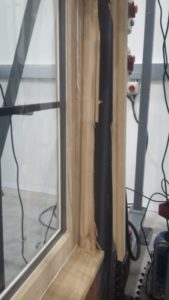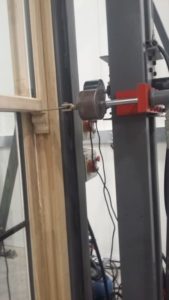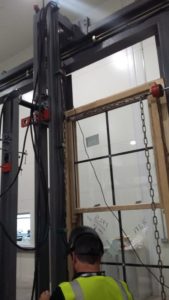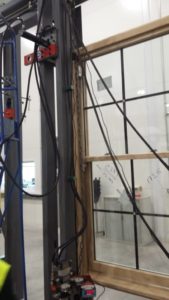Gowercroft timber windows pass new PAS-24 2016 home security tests with flying colours
Home Security something that we take very seriously at Gowercroft.
That’s why, as part of our commitment to delivering the highest quality products, we have put our classic range of timber windows through the UK’s the latest security standards, known as: UKAS PAS-24 2016.
These stringent regulations, which apply to both doors and windows, are designed to give complete confidence that PAS-24 certified products are secure enough to help protect your property from intruders.
I’m pleased to announce that our Hardwick casement windows, (in both Red Grandis hardwood and Accoya), our single and double doors and our Chatsworth Sliding Sash windows (with spiral balances) all passed the security tests with flying colours!
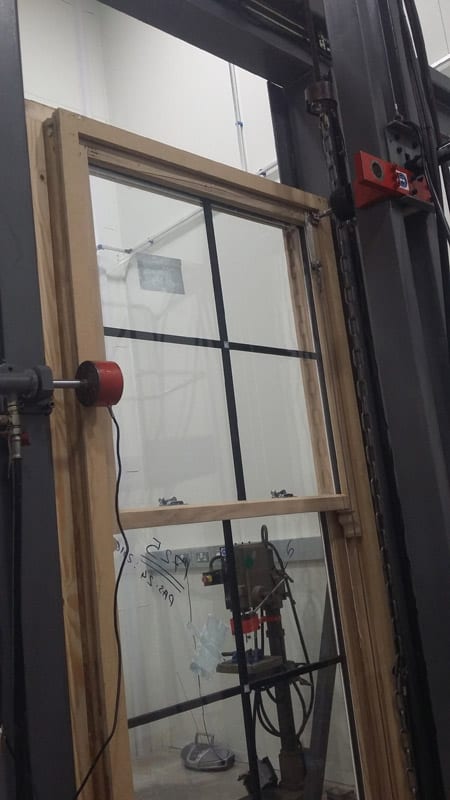
Home security window testing at Gowercroft Joinery
What does the home security testing process involve?
The tests are very strict and, in order to pass, products have to go through a number of specific security assessments. Here’s an overview what’s involved with one or two photographs we managed to take at the testing house to illustrate!
The Home security testing process
As the process varies according to product type, I’ll focus on our Sliding Sash windows to guide you through the different stages:-
- Preparation. First, a sample window is fitted into in a softwood frame, which was tightly fixed into the metal test rig to simulate an installation in an ordinary house. The size of the sample is important as it tends to be harder for larger samples to pass and because the certification only covers products of the size tested or smaller. In our case, we tested a product large enough to cover 98{d8e1452010c92644c7cdf56fc9896e17f5a7eff5f88511842cd8c66c0baa911a} of all Sliding Sash windows we manufacture!
- Manipulation Test. In this test, a trained operative is given 15 minutes to try to gain entry through the window (defined as a clear opening of 100mm) using a standard set of tools, which include credit cards, paint scrapers, craft knives and flathead screwdrivers. The operative would typically attempt to remove the outer trims, external hardware and use force to try to dislodge the locking devices.
- Infill Medium Removal Manual Test. This is a direct 3-minute attack on the glazing carried out using the same tools as above, plus chisels, bolsters and larger screwdrivers. The intention is to see if the beads and glass can be removed to allow entry.
- Infill Medium Removal Mechanical Test. This follows on from the medium removal manual test. A 2kN load is applied to each corner of the glazing to see if the glass can be pushed through. This test is held under full pressure for 12 seconds and if there is the slightest bit of deterioration, the test is then carried out all along the whole length of the glass.
- Mechanical Loading Test. This test involves placing parallel, perpendicular and vertical loads on the sashes in a variety of configurations and strengths in order to get the ironmongery or timber elements to fail. This includes putting up to 3kN loads in opposite directions at the same time.
- Manual Check Test. This is a 15-minute manual attack, using all the tools from the infill medium removal manual test in order to build on any weaknesses created during the preceding tests.
- Additional Mechanical Loading Test. This final stage of the testing repeats the Mechanical Loading Test in order to capitalise on any weaknesses created during the manual check test.
It’s worth bearing in mind that each of these demanding tests is carried out progressively and on the same test sample.
I’m pleased to say that Gowercroft’s timber windows passed all the tests with without the need for any modifications whatsoever to the range!
Why is this standard important for home security?
A major concern for homeowners and developers is that the new windows and doors they install help protect their property from intruders.
Part Q of the Building Regulations stipulates that any product being installed into an accessible opening (ground or first floor) in a new building since October 2015 must meet UKAS PAS-24 2016 or its equivalent. This stipulation is open to interpretation, which can vary according to the Local Authority or even the Building Control Officer.
However, at Gowercroft, we believe in the importance of offering the full UKAS PAS-24 2016 test certification, as the most a rigorously tested bona fide way of demonstrating that our wooden windows and doors are secure enough for your home.
If you would like to understand more about our timber windows and doors, we would be delighted to show you around our workshop and explain the security features and their benefits for home security. Feel free to give us a call on 01773 300510 to discuss how our products can help with home security.

